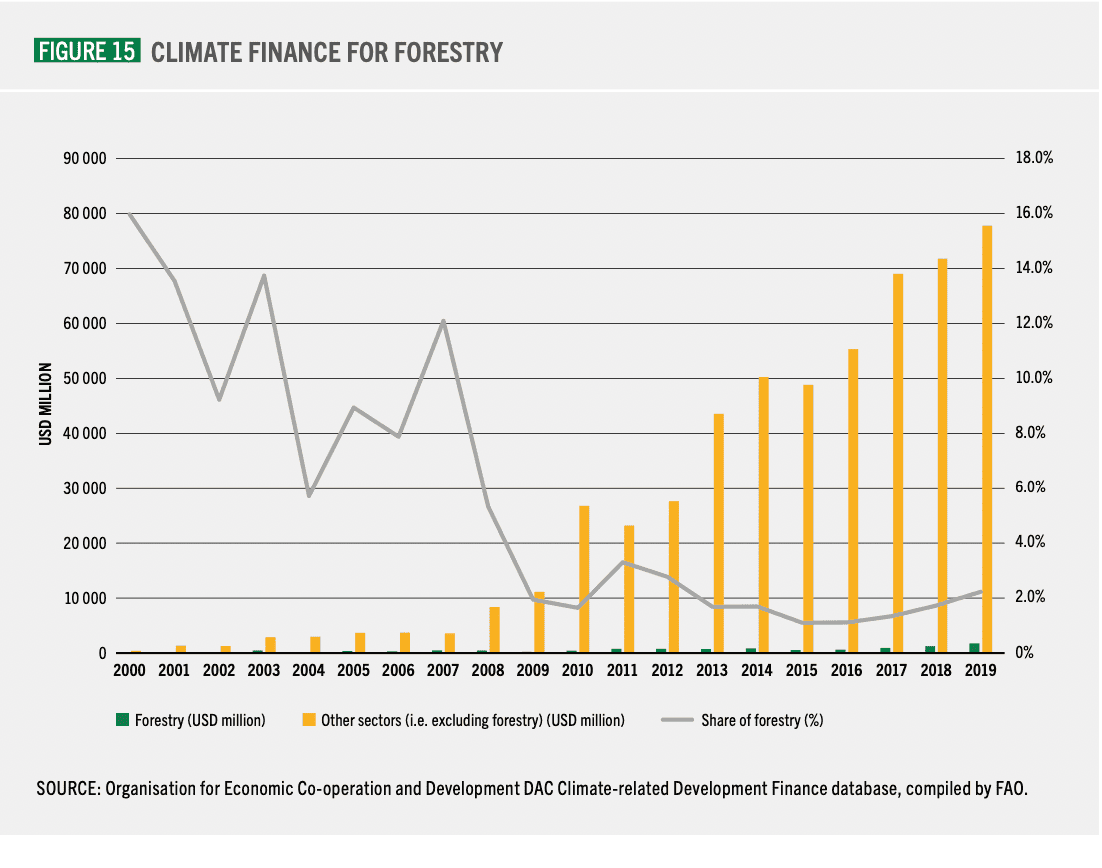In its 2022 Annual Report: "The State of the World's Forests 2022. Forest solutions for a green recovery and inclusive, resilient, and sustainable economies", the FAO deplores that forests only receive about 2 % of funding dedicated to climate action. Yet they are the first terrestrial carbon sink - outside the oceans. They are also home to 80% of biodiversity.
Notably, the international organization sees in its report the private sector as an essential source of funding for the forest sector – particularly for restoration or sustainable solutions. Therefore, according to the institution, it is necessary to develop portfolios of projects capable of attracting investments of different kinds.
The need to increase funding
Globally, investment in forestry projects is well below the required level. Indeed, according to the FAO 2022 report, total funding for forest solutions would need to triple by 2030. It could quadruple by 2050 if we achieve global goals for climate, biodiversity, and the fight against land degradation. In addition, funding for forest management and creation alone would need to rise to USD 203 billion annually by 2050.

The need for companies to act to ensure their profitability, even their long-term survival
According to the World Economic Forum (WEF), 50% of global GDP depends on nature and its ecosystem services. The latter provides many resources free of charge to companies to produce goods and services. However, their degradation exposes them to many risks - such as the reduction of raw materials or the decline in their quality, the increase in their costs, the deterioration of supply chains, and the disruption of business activities, for instance. Moreover, companies can also exert pressures responsible for the degradation of natural environments - directly through their operations or activities upstream or downstream of their value chain. Therefore, companies have an interest in acting and a duty to act.
Priority actions:
In its report, the FAO puts forward three solutions:
1. Halting deforestation and restoring degraded lands:
Halting deforestation would prevent the emission of 3.6 +/- 2 gigatonnes of carbon dioxide equivalent per year between 2020 and 2050. In addition, it would preserve more than half of terrestrial biodiversity. Around 2.2 billion hectares of degraded land could be restored globally. According to the FAO, restoring degraded land through afforestation or reforestation could cost-effectively remove from the atmosphere 0.9 to 1.5 Gt CO2eq per year over 2020.-2050. Fixing would also improve the provision of ecosystem services. A meta-analysis concluded that restoration increased biodiversity and the provision of ecosystem services by an average of 44 and 25 percent, respectively, compared to levels found in degraded systems. Restoring 350 million hectares of deforested or degraded land by 2030 could bring a net benefit of USD 700-9 trillion and USD 7-30 for every dollar invested.
2. The expansion of agroforestry:
FAO encourages the development of agroforestry. Indeed, agroforestry systems generally resist environmental shocks and the effects of climate change better than conventional agriculture. Depending on the system and local conditions, they can also have a biodiversity equivalent to 50 or even 80 percent of that of natural forests. They also increase food security and nutrition because they provide a safety net. In addition, they allow an increase in crop productivity. Well-planned and executed restoration investments result in a net economic benefit.
FAO thus emphasizes the need to provide incentives and make strategic investments to achieve the objectives of restoring and improving production on a larger scale.
3. Sustainable use of forests and creation of environmentally friendly value chains:
Such creations of value chains would support the sustainability of economies through better job prospects and more secure livelihoods. In addition, societies could make better use of forests and trees to preserve biodiversity and better ensure human well-being and generate income, especially among rural populations. According to the FAO, smallholders, local communities, and indigenous peoples will have a crucial role to play in scaling up forestry solutions.
References :
Haut Conseil pour le Climat, « Dépasser les constats, mettre en œuvre les solutions », rapport 2022.